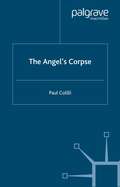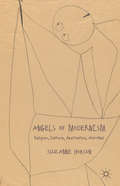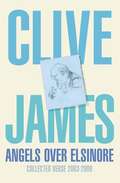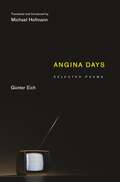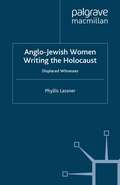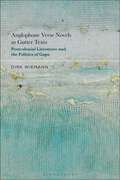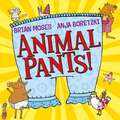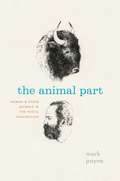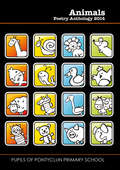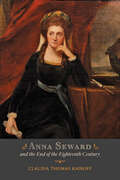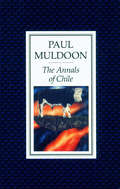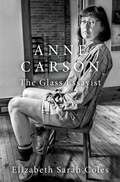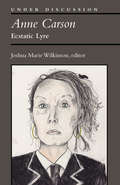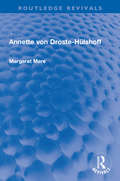- Table View
- List View
The Angel’s Corpse (Semaphores and Signs)
by P. ColilliWith the great merit of Aristotle's Poetics , poetic logic became a theoretical activity endowed with a philosophical nature allowing it to be more philosophical than the pure representation of existence. Today, however, the theoretical status of poetic logic has been greatly demoted. The Angel's Corpse restores to poetic logic (or lyric philosophy) the cognitive and epistemological significance attributed to it by Aristotle. The Angel's corpse (the central metaphor in this restoration) is a sign-post beyond which there exists an uncharted terrain of human signification. This terrain is expressed in terms of lyric philosophy and its universal trait is a shocking into reawakening, which is linked to the dissolution of the repetitive logic of history. With this book, Colilli aims to bring to life the traits that are close to the Angel and which amount to a new philosophy of culture and interpretation. This philosophy is free from the ideological burden of previous systems, but pivots its cognito-epistemological premises on the idea of reawakening.
Angels of Modernism: Religion, Culture, Aesthetics 1910-1960
by S. HobsonThe angel can be viewed as a signal reference to modernist attempts to accommodate religious languages to self-consciously modern cultures. This book uses the angel to explore the relations between modernist literature and early twentieth-century debates over the secular and/or religious character of the modern age.
Angels Over Elsinore: Collected Verse 2003-2008
by Clive JamesClive James, our most brilliant prose stylist, is also a naturally gifted poet, and Angels Over Elsinore: Collected Verse 2003-2008 is his most accomplished collection of poetry to date. From reminiscences of his Australian childhood and elegies for friends and family to hilarious observations on the state of the language in the twenty-first century and reflections on art, metaphysics, science and faith, Angels Over Elsinore is simultaneousIy witty, passionate and provocative. Fired by the same energy and rigorous intelligence as his prose, his verse displays a breathtaking range – but for all its dazzling variety, one theme sings through James’s inexhaustible fascination with his fellow humans.
Angina Days: Selected Poems
by Günter Eich Michael HofmannThis is the most comprehensive English translation of the work of Günter Eich, one of the greatest postwar German poets. The author of the POW poem "Inventory," among one of the most famous lyrics in the German language, Eich was rivaled only by Paul Celan as the leading poet in the generation after Gottfried Benn and Bertolt Brecht. Expertly translated and introduced by Michael Hofmann, this collection gathers eighty poems, many drawn from Eich's later work and most of them translated here for the first time. The volume also includes the original German texts on facing pages. As an early member of "Gruppe 47" (from which Günter Grass and Heinrich Böll later shot to prominence), Eich (1907-72) was at the vanguard of an effort to restore German as a language for poetry after the vitriol, propaganda, and lies of the Third Reich. Short and clear, these are timeless poems in which the ominousness of fairy tales meets the delicacy and suggestiveness of Far Eastern poetry. In his late poems, he writes frequently, movingly, and often wryly of infirmity and illness. "To my mind," Hofmann writes, "there's something in Eich of Paul Klee's pictures: both are homemade, modest in scale, immediately delightful, inventive, cogent." Unjustly neglected in English, Eich finds his ideal translator here.
Angina Days: Selected Poems (PDF)
by Günter Eich Michael HofmannThis is the most comprehensive English translation of the work of Günter Eich, one of the greatest postwar German poets. The author of the POW poem "Inventory," among one of the most famous lyrics in the German language, Eich was rivaled only by Paul Celan as the leading poet in the generation after Gottfried Benn and Bertolt Brecht. Expertly translated and introduced by Michael Hofmann, this collection gathers eighty poems, many drawn from Eich's later work and most of them translated here for the first time. The volume also includes the original German texts on facing pages. As an early member of "Gruppe 47" (from which Günter Grass and Heinrich Böll later shot to prominence), Eich (1907-72) was at the vanguard of an effort to restore German as a language for poetry after the vitriol, propaganda, and lies of the Third Reich. Short and clear, these are timeless poems in which the ominousness of fairy tales meets the delicacy and suggestiveness of Far Eastern poetry. In his late poems, he writes frequently, movingly, and often wryly of infirmity and illness. "To my mind," Hofmann writes, "there's something in Eich of Paul Klee's pictures: both are homemade, modest in scale, immediately delightful, inventive, cogent." Unjustly neglected in English, Eich finds his ideal translator here.
Anglo-Jewish Women Writing the Holocaust: Displaced Witnesses
by P. LassnerIn its analysis of Anglo-Jewish women writing the Holocaust, this book highlights the necessity of their inclusion in the evolving canon of modern British literature, by showing how these writers complicate theories of trauma and memory by using fantasy and the Gothic as a response to silence.
Anglo Saxon Poetry: Anglo Saxon Poetry (Everyman)
by S.A.J. BradleyAnglo-saxon poetry was circulated orally in a preliterate society, and gathered at last into books over some six centuries before the Norman Conquest ended English independence. Against the odds some of these books survive today. This anthology of prose translations covers most of the surviving poetry, revealing a tradition which is outstanding among early medieval literatures for its sophisticated exploration of the human condition in a mutable, finite, but wonderfully diverse and meaning-filled world.
The Anglo-Scottish Ballad and its Imaginary Contexts (PDF)
by David AtkinsonThis is the first book to combine contemporary debates in ballad studies with the insights of modern textual scholarship. Just like canonical literature and music, the ballad should not be seen as a uniquely authentic item inextricably tied to a documented source, but rather as an unstable structure subject to the vagaries of production, reception, and editing. Among the matters addressed are topics central to the subject, including ballad origins, oral and printed transmission, sound and writing, agency and editing, and textual and melodic indeterminacy and instability. While drawing on the time-honoured materials of ballad studies, the book offers a theoretical framework for the discipline to complement the largely ethnographic approach that has dominated in recent decades. Primarily directed at the community of ballad and folk song scholars, the book will be of interest to researchers in several adjacent fields, including folklore, oral literature, ethnomusicology, and textual scholarship.
Anglophone Verse Novels as Gutter Texts: Postcolonial Literature and the Politics of Gaps
by Dirk WiemannAnglophone Verse Novels as Gutter Texts draws on the notion of the 'gutter' in graphic narratives – the gap between panels that a reader has to imaginatively fill to generate narrative sequence – to analyse the largely overlooked literary form of the verse novel. Marked at all levels by the tense constellation of segment and sequence, and a conspicuously 'gappy' texture, verse novels offer productive alternatives to the dominant prose novel in contemporary fiction, where a similar 'gappiness' has become a hallmark, as illustrated by the loosely interlaced multi-strand plot structures of influential 'world novels' (Bolaño, Mitchell, Powers).The verse novel is a form particularly prolific in the postcolonial world and among diasporic or minoritarian writers in the Global North. This study concentrates on two of the most prominent areas in which verse novels distinguish themselves from the prose novel to read texts by Derek Walcott, Anne Carson, Bernardine Evaristo, Patience Agbabi and others: In 'planetary' verse novels from the Caribbean, Canada, Samoa and Hawai'i, the central trope of the volcano evokes a world in constant un/making; while post-national verse novels, particularly in Britain, modify the established paradigms of imagined communities. Dirk Wiemann's study speculates whether the resurgence of verse novels correlates with the apprehension of inhabiting a world that has become unpredictable and dangerous but also promising: a 'post-prosaic' world.
Anglophone Verse Novels as Gutter Texts: Postcolonial Literature and the Politics of Gaps
by Dirk WiemannAnglophone Verse Novels as Gutter Texts draws on the notion of the 'gutter' in graphic narratives – the gap between panels that a reader has to imaginatively fill to generate narrative sequence – to analyse the largely overlooked literary form of the verse novel. Marked at all levels by the tense constellation of segment and sequence, and a conspicuously 'gappy' texture, verse novels offer productive alternatives to the dominant prose novel in contemporary fiction, where a similar 'gappiness' has become a hallmark, as illustrated by the loosely interlaced multi-strand plot structures of influential 'world novels' (Bolaño, Mitchell, Powers).The verse novel is a form particularly prolific in the postcolonial world and among diasporic or minoritarian writers in the Global North. This study concentrates on two of the most prominent areas in which verse novels distinguish themselves from the prose novel to read texts by Derek Walcott, Anne Carson, Bernardine Evaristo, Patience Agbabi and others: In 'planetary' verse novels from the Caribbean, Canada, Samoa and Hawai'i, the central trope of the volcano evokes a world in constant un/making; while post-national verse novels, particularly in Britain, modify the established paradigms of imagined communities. Dirk Wiemann's study speculates whether the resurgence of verse novels correlates with the apprehension of inhabiting a world that has become unpredictable and dangerous but also promising: a 'post-prosaic' world.
Animal Pants: from the bestselling Pants series
by Giles Andreae*A brand new laugh-out-loud book in the bestselling PANTS series*Baa pants, moo pants, COCK-A-DOODLE-DO pants . . .Have you ever wondered what kind of pants honey bees wear? What about iguanas? Or even piranhas?Find out in this joyous explosion of colour and silliness that will have readers of all ages laughing together - a hilarious rhyming read, from the author of Giraffes Can't Dance and the illustrator of You Choose.
Animal Pants
by Brian MosesFrom long johns to bloomers, Y-fronts to boxers - Animal Pants is quite simply packed with pants! There's a cat who buys her pants from a catalogue and a frog who wears pants when he's off for a jog. Not to mention a penguin with frozen pants, or the difficulties of finding undies for an octopus. With an infectious rhyming text from the brilliant Brian Moses, and wonderfully entertaining artwork by Anja Boretzki, there's a giggle guaranteed on every page.
The Animal Part: Human and Other Animals in the Poetic Imagination
by Mark PayneHow can literary imagination help us engage with the lives of other animals? The question represents one of the liveliest areas of inquiry in the humanities, and Mark Payne seeks to answer it by exploring the relationship between human beings and other animals in writings from antiquity to the present. Ranging from ancient Greek poets to modernists like Ezra Pound and William Carlos Williams, Payne considers how writers have used verse to communicate the experience of animal suffering, created analogies between human and animal societies, and imagined the kind of knowledge that would be possible if human beings could see themselves as animals see them. The Animal Part also makes substantial contributions to the emerging discourse of the posthumanities. Payne offers detailed accounts of the tenuousness of the idea of the human in ancient literature and philosophy and then goes on to argue that close reading must remain a central practice of literary study if posthumanism is to articulate its own prehistory. For it is only through fine-grained literary interpretation that we can recover the poetic thinking about animals that has always existed alongside philosophical constructions of the human. In sum, The Animal Part marks a breakthrough in animal studies and offers a significant contribution to comparative poetics.
The Animal Part: Human and Other Animals in the Poetic Imagination
by Mark PayneHow can literary imagination help us engage with the lives of other animals? The question represents one of the liveliest areas of inquiry in the humanities, and Mark Payne seeks to answer it by exploring the relationship between human beings and other animals in writings from antiquity to the present. Ranging from ancient Greek poets to modernists like Ezra Pound and William Carlos Williams, Payne considers how writers have used verse to communicate the experience of animal suffering, created analogies between human and animal societies, and imagined the kind of knowledge that would be possible if human beings could see themselves as animals see them. The Animal Part also makes substantial contributions to the emerging discourse of the posthumanities. Payne offers detailed accounts of the tenuousness of the idea of the human in ancient literature and philosophy and then goes on to argue that close reading must remain a central practice of literary study if posthumanism is to articulate its own prehistory. For it is only through fine-grained literary interpretation that we can recover the poetic thinking about animals that has always existed alongside philosophical constructions of the human. In sum, The Animal Part marks a breakthrough in animal studies and offers a significant contribution to comparative poetics.
The Animal Part: Human and Other Animals in the Poetic Imagination
by Mark PayneHow can literary imagination help us engage with the lives of other animals? The question represents one of the liveliest areas of inquiry in the humanities, and Mark Payne seeks to answer it by exploring the relationship between human beings and other animals in writings from antiquity to the present. Ranging from ancient Greek poets to modernists like Ezra Pound and William Carlos Williams, Payne considers how writers have used verse to communicate the experience of animal suffering, created analogies between human and animal societies, and imagined the kind of knowledge that would be possible if human beings could see themselves as animals see them. The Animal Part also makes substantial contributions to the emerging discourse of the posthumanities. Payne offers detailed accounts of the tenuousness of the idea of the human in ancient literature and philosophy and then goes on to argue that close reading must remain a central practice of literary study if posthumanism is to articulate its own prehistory. For it is only through fine-grained literary interpretation that we can recover the poetic thinking about animals that has always existed alongside philosophical constructions of the human. In sum, The Animal Part marks a breakthrough in animal studies and offers a significant contribution to comparative poetics.
Animals: Poetry 2014 (Wordcatcher Modern Poetry)
by Various AuthorsThis book is a compilation of work from the Year 6 pupils, (Class of 2014), at Pontyclun Primary School, Rhondda Cynon Taff, South Wales. Given the topic of 'Animals' this anthology is a feast of creative ideas featuring spiders, penguins, cats, dogs, and a host of other creatures. Enjoy the humour and inventiveness that the children bring to the subject.
Anna Letitia Barbauld and Eighteenth-Century Visionary Poetics
by Daniel P. WatkinsIn this first critical study of Anna Letitia Barbauld’s major work, Daniel P. Watkins reveals the singular purpose of Barbauld’s visionary poems: to recreate the world based on the values of liberty and justice. Watkins examines in close detail both the form and content of Barbauld’s Poems, originally published in 1773 and revised and reissued in 1792. Along with careful readings of the poems that situate the works in their broader political, historical, and philosophical contexts, Watkins explores the relevance of the introductory epigraphs and the importance of the poems’ placement throughout the volume. Centering his study on Barbauld’s effort to develop a visionary poetic stance, Watkins argues that the deliberate arrangement of the poems creates a coherent portrayal of Barbauld’s poetic, political, and social vision, a far-sighted sagacity born of her deep belief that the principles of love, sympathy, liberty, and pacifism are necessary for a secure and meaningful human reality. In tracing the contours of this effort, Watkins examines, in particular, the tension in Barbauld’s poetry between her desire to engage directly with the political realities of the world and her equally strong longing for a pastoral world of peace and prosperity. Scholars of British literature and women writers will welcome this important study of one of the eighteenth century’s foremost writers.
Anna Letitia Barbauld and Eighteenth-Century Visionary Poetics
by Daniel P. WatkinsIn this first critical study of Anna Letitia Barbauld’s major work, Daniel P. Watkins reveals the singular purpose of Barbauld’s visionary poems: to recreate the world based on the values of liberty and justice. Watkins examines in close detail both the form and content of Barbauld’s Poems, originally published in 1773 and revised and reissued in 1792. Along with careful readings of the poems that situate the works in their broader political, historical, and philosophical contexts, Watkins explores the relevance of the introductory epigraphs and the importance of the poems’ placement throughout the volume. Centering his study on Barbauld’s effort to develop a visionary poetic stance, Watkins argues that the deliberate arrangement of the poems creates a coherent portrayal of Barbauld’s poetic, political, and social vision, a far-sighted sagacity born of her deep belief that the principles of love, sympathy, liberty, and pacifism are necessary for a secure and meaningful human reality. In tracing the contours of this effort, Watkins examines, in particular, the tension in Barbauld’s poetry between her desire to engage directly with the political realities of the world and her equally strong longing for a pastoral world of peace and prosperity. Scholars of British literature and women writers will welcome this important study of one of the eighteenth century’s foremost writers.
Anna Seward and the End of the Eighteenth Century
by Claudia T. KairoffAnna Seward and her career defy easy placement into the traditional periods of British literature. Raised to emulate the great poets John Milton and Alexander Pope, maturing in the Age of Sensibility, and publishing during the early Romantic era, Seward exemplifies the eighteenth-century transition from classical to Romantic. Claudia Thomas Kairoff’s excellent critical study offers fresh readings of Anna Seward’s most important writings and firmly establishes the poet as a pivotal figure among late-century British writers. Reading Seward’s writing alongside recent scholarship on gendered conceptions of the poetic career, patriotism, provincial culture, sensibility, and the sonnet revival, Kairoff carefully reconsiders Seward’s poetry and critical prose. Written as it was in the last decades of the eighteenth century, Seward’s work does not comfortably fit into the dominant models of Enlightenment-era verse or the tropes that characterize Romantic poetry. Rather than seeing this as an obstacle for understanding Seward’s writing within a particular literary style, Kairoff argues that this allows readers to see in Seward’s works the eighteenth-century roots of Romantic-era poetry. Arguably the most prominent woman poet of her lifetime, Seward’s writings disappeared from popular and scholarly view shortly after her death. After nearly two hundred years of critical neglect, Seward is attracting renewed attention, and with this book Kairoff makes a strong and convincing case for including Anna Seward's remarkable literary achievements among the most important of the late eighteenth century.
Anna Seward and the End of the Eighteenth Century
by Claudia T. KairoffAnna Seward and her career defy easy placement into the traditional periods of British literature. Raised to emulate the great poets John Milton and Alexander Pope, maturing in the Age of Sensibility, and publishing during the early Romantic era, Seward exemplifies the eighteenth-century transition from classical to Romantic. Claudia Thomas Kairoff’s excellent critical study offers fresh readings of Anna Seward’s most important writings and firmly establishes the poet as a pivotal figure among late-century British writers. Reading Seward’s writing alongside recent scholarship on gendered conceptions of the poetic career, patriotism, provincial culture, sensibility, and the sonnet revival, Kairoff carefully reconsiders Seward’s poetry and critical prose. Written as it was in the last decades of the eighteenth century, Seward’s work does not comfortably fit into the dominant models of Enlightenment-era verse or the tropes that characterize Romantic poetry. Rather than seeing this as an obstacle for understanding Seward’s writing within a particular literary style, Kairoff argues that this allows readers to see in Seward’s works the eighteenth-century roots of Romantic-era poetry. Arguably the most prominent woman poet of her lifetime, Seward’s writings disappeared from popular and scholarly view shortly after her death. After nearly two hundred years of critical neglect, Seward is attracting renewed attention, and with this book Kairoff makes a strong and convincing case for including Anna Seward's remarkable literary achievements among the most important of the late eighteenth century.
The Annals of Chile
by Paul MuldoonThe Annals of Chile is Paul Muldoon's seventh collection of poems and contains, amongst other things, celebrations of the birth of his daughter, a plangent and frankly personal lament fo the artist Mary Farl Powers, and a long fantasy invoking the world of boys' adventure stories, over which the poet's mother presides as a benign influence.
Anne Carson: The Glass Essayist
by Elizabeth Sarah ColesThe scholar is transparent and accountable, the poet inward and errant: anyone who reads Anne Carson has to suspend many such separations of power. The first monographic study of her work to date, Anne Carson: The Glass Essayist makes the case for the acclaimed poet, classicist, and translator as a remarkable experimental scholar and reader, who rehearses scholarly methods while slipping their constraints of form and emotion. Carson's attention to sources-ancient and modern, textual or visual-is one of few constants across almost four decades of her published writing, whose uncertain claims on discipline and genre are claimed here as a certain interpretive style. The book follows Carson's readings through variations in form-from early academic prose and poem-essays to creative adaptations and works for performance-to come to grips with what Coles calls Carson's transparency: not her easiness or literalism, but a taste for the exposure of her presence, process, and intent. Carson's portraits of working perform to readers even where she fantasizes her own erasure; where chance, poetic economy, impersonation, and imitation ride the line of anonymity. Coles situates Carson in a vibrant contemporary conversation around the essay, scholar-poets, and post-critical form, where creation transacts critique, and where roles and prerogatives are reset. Reading Carson as a reader, the book argues, is the most pressing way of reading her now.
Anne Carson: The Glass Essayist
by Elizabeth Sarah ColesThe scholar is transparent and accountable, the poet inward and errant: anyone who reads Anne Carson has to suspend many such separations of power. The first monographic study of her work to date, Anne Carson: The Glass Essayist makes the case for the acclaimed poet, classicist, and translator as a remarkable experimental scholar and reader, who rehearses scholarly methods while slipping their constraints of form and emotion. Carson's attention to sources-ancient and modern, textual or visual-is one of few constants across almost four decades of her published writing, whose uncertain claims on discipline and genre are claimed here as a certain interpretive style. The book follows Carson's readings through variations in form-from early academic prose and poem-essays to creative adaptations and works for performance-to come to grips with what Coles calls Carson's transparency: not her easiness or literalism, but a taste for the exposure of her presence, process, and intent. Carson's portraits of working perform to readers even where she fantasizes her own erasure; where chance, poetic economy, impersonation, and imitation ride the line of anonymity. Coles situates Carson in a vibrant contemporary conversation around the essay, scholar-poets, and post-critical form, where creation transacts critique, and where roles and prerogatives are reset. Reading Carson as a reader, the book argues, is the most pressing way of reading her now.
Anne Carson: Ecstatic Lyre (Under Discussion)
by Joshua M WilkinsonAnne Carson’s works re-think genre in some of the most unusual and nuanced ways that few writers ever attempt, from her lyric essays, enigmatic poems, and novels in verse to further forays into video and comics and collaborative performance. Carson’s pathbreaking translations of Ancient Greek poetry and drama, as well as her scholarship on everything from Sappho to Celan, only continue to demonstrate the unique vision she has for what’s possible for a work of literature to become. Anne Carson: Ecstatic Lyre is the first book of essays dedicated to the breadth of Anne Carson’s works, individually, spanning from Eros the Bittersweet through Red Doc. With contributions from Kazim Ali, Dan Beachy-Quick, Julie Carr, Harmony Holiday, Cole Swensen, Eleni Sikelianos, and many others (including translators, poets, essayists, scholars, novelists, critics, and collaborators themselves), we learn from Carson’s greatest admirers and closest readers about the books that moved and inspired them.
Annette von Droste-Hülshoff (Routledge Revivals)
by Margaret MareFirst published in 1965, Annette von Droste-Hülshoff is the first book about the great German poetess of the early nineteenth century in English. Delicate, fey, over-sensitive, unstable, with the intellect often described as unbecomingly masculine, it is easy to see how Annette von Droste-Hülshoff was bound to flout the conventions of the conservative society she lived in and to suffer accordingly. But melancholy and despairing as many of her poems are, we are never allowed to imagine her as a weak person. Margaret Mare is careful to show us her trenchant humour, her gift of mimicry, her generosity to her friends, the resolution which made her refuse, in the middle of a dangerous illness, to treat herself ‘like a soap bubble or a soft egg’—giving us a full picture of the woman of genius who could prophesy confidently that her works would still be read a hundred years after her death. Divided into three parts the book deals with the poet’s life and background, detailed interpretations of selected poems, and, the poet’s treatment of supernatural themes, her epics and prose works, her style and use of images. This book will be an essential read for scholars and researchers of poetry, literature, German literature, European literature, and comparative literature.
